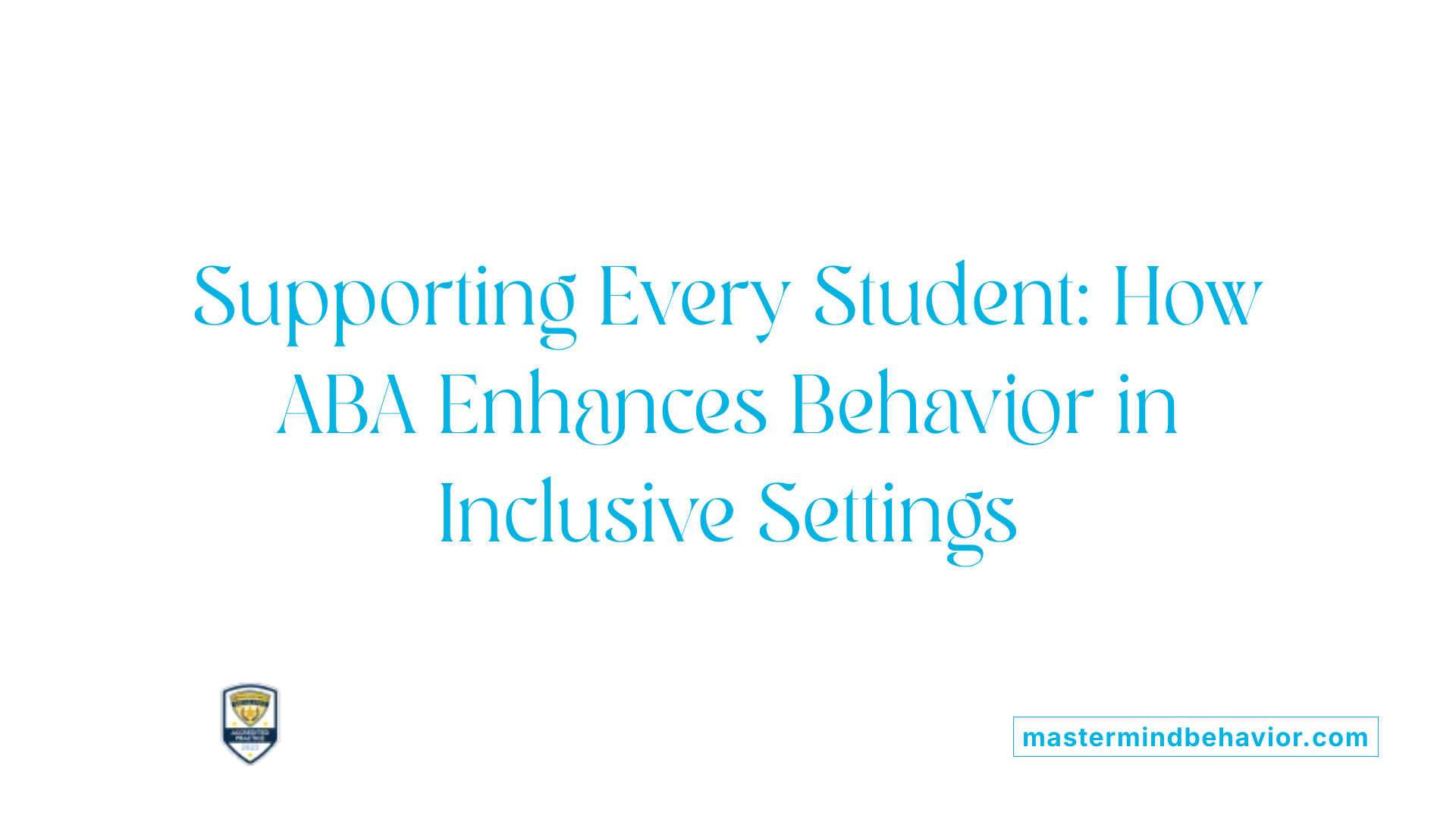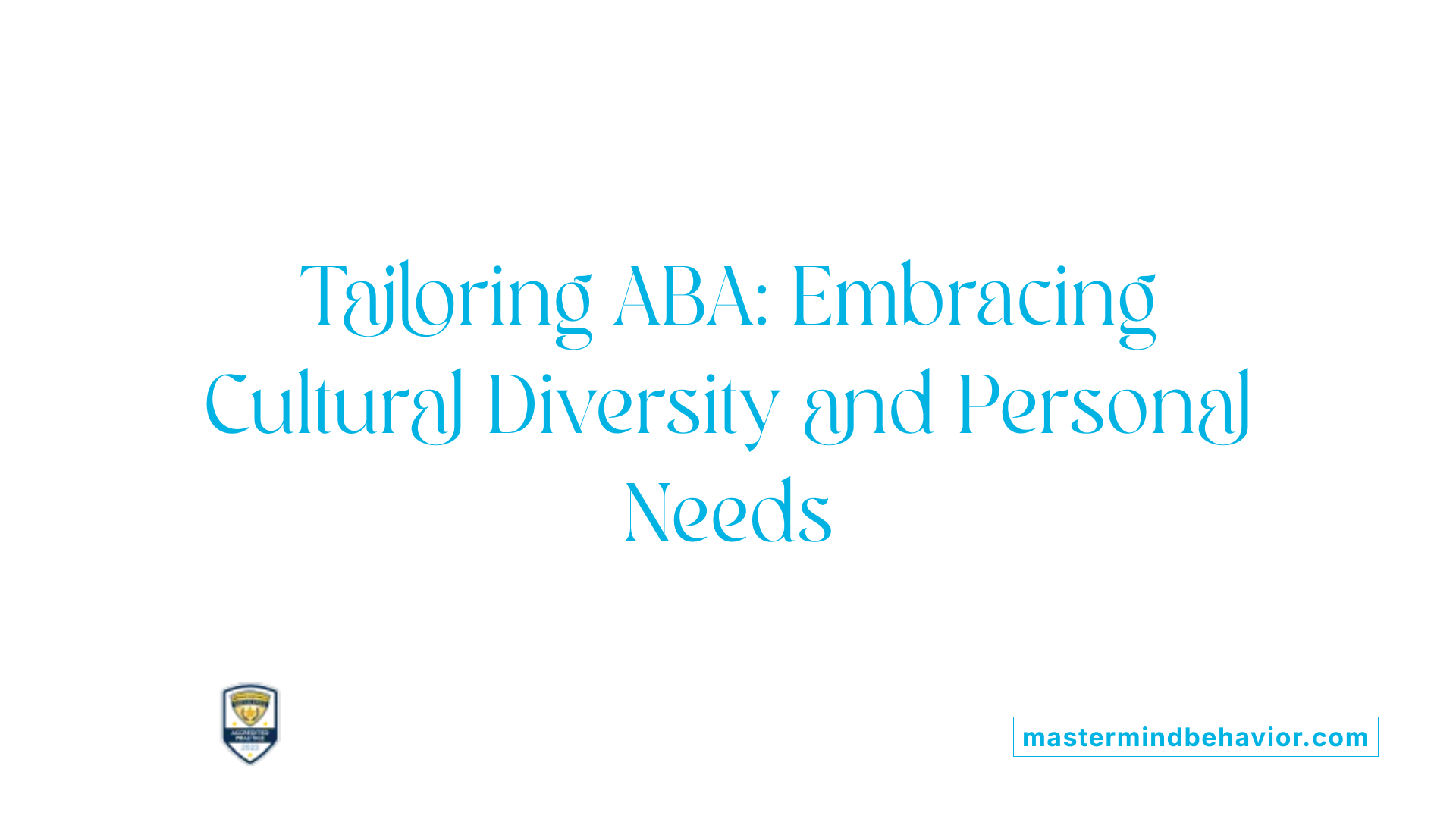Integrating ABA Therapy into Inclusive Classrooms
Inclusive classrooms welcome students of all abilities, creating a diverse learning environment that promotes social interaction and shared experiences. However, managing the varied behavioral and developmental needs of students, particularly those with autism spectrum disorder (ASD), often presents challenges. Applied Behavior Analysis (ABA) therapy, an evidence-based approach, offers effective strategies to improve behaviors and foster essential skills, making inclusion more successful. This article explores how ABA therapy improves behavior in inclusive classrooms, highlighting its principles, techniques, and benefits for students with autism and peers alike.
Understanding Applied Behavior Analysis (ABA) Therapy
What is Applied Behavior Analysis (ABA) therapy?
Applied Behavior Analysis (ABA) therapy is a scientifically based approach focused on understanding how behavior is influenced by the environment and how learning occurs. It aims to increase helpful behaviors such as communication, social skills, and self-care, while decreasing harmful or impairing behaviors. This is achieved through systematic teaching and reinforcement techniques like positive reinforcement and prompting.
Principles and Role of Environment in Behavior
ABA operates by breaking down complex behaviors into smaller, manageable steps, teaching these steps systematically. The environment plays a crucial role, as behaviors are seen as responses influenced by environmental factors. ABA uses data collection and analysis to identify which environmental changes can help teach or modify behaviors effectively.
Individualized Nature of ABA Programs
Each ABA program is tailored to the individual's unique developmental needs. These programs are designed by Board Certified Behavior Analysts (BCBAs) and implemented under the supervision of Registered Behavior Technicians (RBTs). Techniques such as Discrete Trial Training, Pivotal Response Training, and naturalistic teaching methods are employed to ensure skills are acquired and generalized across different settings like homes, schools, and clinics.
Evidence Base Supporting ABA
ABA is recognized as an evidence-based therapy by major health organizations for treating autism spectrum disorder and other developmental challenges. Research shows significant improvements in intellectual functioning, language development, social skills, and daily living abilities in children receiving ABA therapy. Early intensive intervention especially enhances outcomes due to brain plasticity during preschool years, making ABA a vital approach for fostering meaningful, lasting behavioral change.
How ABA Therapy Supports Behavior in Inclusive Classrooms

Behavioral challenges in inclusive classrooms
Inclusive classrooms bring together students with diverse needs, including those with autism spectrum disorder (ASD). Children with ASD may face difficulties such as social skill deficits, communication challenges, and problematic behaviors that can disrupt learning for themselves and others. These behavioral challenges require effective support strategies to foster an inclusive and productive environment.
How ABA modifies behavior
Applied Behavior Analysis (ABA) therapy addresses these challenges by carefully analyzing behavior through its antecedents and consequences. It breaks down complex behaviors into manageable steps and develops individualized programs to target specific skills and behaviors. ABA therapists work systematically to teach new skills and modify behaviors by focusing on what triggers and reinforces them.
Positive reinforcement and teaching desired behaviors
A cornerstone of ABA therapy is positive reinforcement—rewarding desirable behaviors to increase their occurrence. For example, when a child appropriately raises their hand to speak, immediate praise or a reward encourages this behavior to become more frequent. This method helps children with ASD learn essential social, communication, and daily living skills in a structured and supportive setting. Techniques like Discrete Trial Training and Pivotal Response Training provide effective, evidence-based approaches to skill acquisition.
Reducing problem behaviors
ABA not only promotes skill development but aims to reduce problem behaviors by identifying their causes and replacing them with positive alternatives. Through consistent reinforcement of appropriate behaviors and teaching replacement strategies, behaviors such as aggression or self-injury can diminish. This dual focus helps create a more inclusive classroom atmosphere where all students can engage and thrive.
How does ABA therapy benefit individuals with autism?
ABA therapy benefits individuals with autism by improving essential skills such as communication, social interaction, and daily living activities through evidence-based techniques. It helps understand and modify behaviors by analyzing antecedents and consequences, and uses positive reinforcement to promote helpful behaviors while reducing challenging or harmful ones. ABA programs are highly individualized, tailored to each person's needs, and can be delivered in various settings like home, school, or community. Early, intensive intervention with ABA has been shown to significantly enhance language development, social skills, and adaptive behaviors, leading to better long-term outcomes. Overall, ABA provides a scientifically supported approach that equips individuals with autism to better navigate their environments and improve their quality of life.
Key Techniques Employed in ABA Therapy for Inclusive Education
What techniques are commonly used in ABA therapy?
ABA therapy utilizes a variety of structured and evidence-based techniques designed to teach new skills and reduce challenging behaviors effectively. Key methods include:
Discrete Trial Training (DTT): This technique breaks skills into small, teachable steps delivered in a structured manner. It involves clear instructions, prompts, and immediate reinforcement to build specific skills.
Natural Environment Teaching (NET): Unlike DTT’s structured setting, NET harnesses everyday situations and environments such as classrooms or playgrounds to encourage learning. This approach helps generalize skills naturally.
Positive Reinforcement: Central to ABA, this strategy encourages desirable behaviors by providing motivating rewards or praise immediately following the behavior.
Prompting and Fading: These methods guide learners through new tasks by offering assistance initially (prompting) and then gradually reducing support (fading) as independence grows.
Behavior Chaining: Complex behaviors are divided into smaller, manageable actions which are taught sequentially. Each step acts as a link in the chain toward the full behavior.
Modeling and Redirection: Modeling involves demonstrating appropriate behaviors for the learner to imitate, while redirection steers attention away from problematic behaviors toward positive activities.
These techniques are individualized for each learner, based on assessments by Board Certified Behavior Analysts (BCBAs) and carried out by Registered Behavior Technicians (RBTs). Through consistent application, these strategies effectively foster communication, social skills, and adaptive behaviors essential for inclusion and daily functioning in educational settings.
The Role of Board Certified Behavior Analysts and Therapy Teams
Who typically provides ABA therapy?
ABA therapy is generally delivered by a team of trained professionals, with Board Certified Behavior Analysts (BCBAs) taking the lead role. BCBAs are responsible for designing and overseeing individualized ABA programs based on each child's unique needs. Alongside BCBAs, Registered Behavior Technicians (RBTs) often provide direct therapy under supervision, implementing techniques and collecting data. Licensed behavior therapists may also be part of the team, working to support a child's progress.
Team collaboration in schools
In school settings, ABA therapy involves close collaboration among therapists, teachers, and other specialists such as speech and occupational therapists. This multidisciplinary approach ensures that therapy goals align with educational objectives and that skills learned in therapy generalize to classroom activities and social interactions. The therapy team shares insights and adapts strategies to support the child's academic and social success.
Development and supervision of individualized programs
Each ABA program is individualized, carefully developed by the BCBA after thorough assessment. These programs break down complex behaviors into manageable steps and utilize positive reinforcement to encourage skill acquisition. The BCBA continuously monitors progress and adjusts the program as needed, while RBTs carry out the day-to-day implementation. This structured supervision ensures that interventions are both effective and responsive to the child's evolving needs.
Importance of parent and teacher involvement
Active involvement of parents and teachers is crucial in ABA therapy. They reinforce newly acquired skills and help generalize behaviors across various environments, leading to better long-term outcomes. Training and communication with families empower them to support the child consistently, making the therapeutic process a collaborative effort that extends beyond therapy sessions.
Importance of Early Intervention with ABA in Inclusive Settings
At what age can individuals start ABA therapy?
ABA therapy can be started at any age, including infancy, childhood, adolescence, and adulthood. However, early intervention is strongly advised, with an optimal starting age between 6 months and 4 years old. Initiating therapy during this early window leverages the brain's heightened plasticity and developmental readiness.
Benefits of early intervention
Starting ABA therapy early supports significant improvements in speech, social interaction, language development, and cognitive skills. Early therapy helps children develop foundational abilities needed for learning and everyday functioning while reducing the occurrence of challenging behaviors. These early gains also translate into better success in later educational and social settings.
Brain plasticity and developmental windows
The preschool years represent a critical developmental period when a child's brain is highly adaptable. This plasticity allows the child to absorb new skills rapidly, making early ABA intervention particularly effective. Implementing therapy when the brain is most responsive ensures more profound and lasting behavioral and communication improvements.
Long-term impact on social and communication skills
Children who receive early ABA treatment often demonstrate enhanced social skills, better communication, and greater independence in daily living skills. These improvements are crucial for inclusion in school and community settings, fostering social integration and a higher quality of life. Early intervention can thus set the stage for lifelong positive outcomes by building a strong developmental foundation.
Through individualized, evidence-based approaches, ABA therapy in early childhood makes a lasting difference, promoting meaningful social change and functional success across multiple environments.
Measuring Progress and Effectiveness in Inclusive Classrooms
How is progress measured during ABA therapy?
Progress during ABA therapy is primarily measured through systematic data collection and ongoing behavioral tracking. Therapists focus on specific target behaviors such as communication gestures, social interactions, or task completion, recording these behaviors consistently to establish clear baselines and monitor trends over time.
Data collection methods
Data may be gathered in multiple ways including direct observation, frequency counts, duration tracking, or more detailed event recording. These methods allow therapists to gather quantitative information on how often or how well a child performs targeted skills or how frequently problem behaviors occur.
Tracking behavior changes
Tracking changes requires careful comparison of collected data against initial baselines or expected benchmarks. Progress is reviewed regularly, helping to identify positive growth or areas needing additional support.
Adjusting interventions based on progress
With regular evaluations, intervention plans are adapted to maintain or increase therapy effectiveness. If progress plateaus or problem behaviors persist, strategies such as altering reinforcement schedules or changing task difficulty are implemented.
Collaboration with educators and families
Effective data collection and progress measurement depend on collaboration among Board Certified Behavior Analysts (BCBAs), Registered Behavior Technicians (RBTs), educators, and families. This team approach ensures consistent implementation of ABA strategies within classrooms and homes and supports generalization and retention of skills learned.
These ongoing, objective measures ensure ABA therapy remains personalized and directed toward achieving meaningful improvements in social and functional skills for children in inclusive classrooms.
Promoting Generalization of Skills Across Settings
How can skills learned in ABA therapy transfer to classroom and home environments?
Generalization, the transfer of skills learned in therapy to everyday settings, is a fundamental goal in ABA therapy. Without this transfer, progress made in clinical sessions may not translate into meaningful real-world improvements. Techniques such as Natural Environment Teaching (NET) are often employed to ensure that children apply new skills in natural, everyday contexts like classrooms or homes.
What is the role of parent and teacher involvement in this process?
Active involvement of parents and teachers is crucial for generalization. When these key figures participate in ABA programs, they can reinforce learned behaviors consistently across environments. This collaboration helps maintain skill retention and encourages the child to use abilities outside of therapy sessions. Training parents and educators to recognize and respond to skill opportunities further fosters this continuity.
How is teaching in the natural environment used?
Natural Environment Teaching integrates learning opportunities into the child's daily routines and activities. For example, during playtime or mealtime, therapists and caregivers prompt the use of newly acquired social or communication skills. This approach supports spontaneous practice and helps the child see the relevance of skills beyond structured therapy.
What strategies support reinforcing behaviors in different contexts?
Systematic strategies such as varying prompts, using generalized reinforcers, and practicing skills in multiple settings enhance generalization. Consistent positive reinforcement is applied not only during therapy but also in homes and schools, making the behaviors functional and meaningful. Parent and teacher collaboration ensures that reinforcement schedules are coherent and aligned, promoting consistent behavioral improvement.
Together, these practices ensure that children with autism retain and effectively use skills across settings, maximizing the impact of ABA therapy on daily life.
ABA Therapy’s Impact on Academic and Social Success
How Does ABA Therapy Improve Intellectual Functioning?
Applied Behavior Analysis (ABA) therapy is backed by extensive research showing its effectiveness in enhancing intellectual functioning in children with autism. Studies such as those by Lovaas (1987) and Smith et al. (2000) highlight significant cognitive gains when children participate in early intensive behavioral interventions. These interventions focus on systematic learning and behavioral improvements, which help children acquire foundational academic skills and improve their ability to engage in learning tasks.
In What Ways Does ABA Enhance Language and Communication?
ABA therapy significantly supports the development of language and communication skills. Through targeted techniques like Discrete Trial Training and Pivotal Response Training, children with autism learn to understand and use language more effectively. Early intervention with ABA, especially starting before age four, takes advantage of the brain’s plasticity to boost speech development and social communication. This early boost helps children better express themselves and interact with others.
How Are Adaptive Daily Living Skills Developed?
ABA therapy programs include teaching adaptive daily living skills that promote independence. These skills range from personal hygiene and dressing to following routines and handling everyday tasks. Such functional skills are broken down into manageable steps and taught systematically with positive reinforcement, enabling children to function more competently in home, school, and community settings.
How Does ABA Address Reduction of Maladaptive Behaviors?
Reducing maladaptive or problem behaviors is a fundamental goal of ABA therapy. By identifying triggers and reinforcing alternative positive behaviors, ABA helps children minimize actions that interfere with learning or social interaction. This reduction facilitates smoother peer interactions and better involvement in educational activities.
What Role Does ABA Play in Supporting Peer Interactions?
ABA also fosters social skills essential for successful peer interactions. Social behaviors, such as turn-taking, initiating conversation, and responding appropriately, are practiced and reinforced in natural environments. Incorporating parent participation and reinforcement strategies strengthens the generalization and retention of these skills, helping children build meaningful relationships in various settings.
| Aspect | ABA-Driven Benefits | Techniques & Implementation |
|---|---|---|
| Intellectual Functioning | Improved cognitive skills and academic engagement | Discrete Trial Training, systematic instruction |
| Language and Communication | Enhanced speech and social communication | Pivotal Response Training, early intensive intervention |
| Adaptive Living Skills | Greater independence in daily tasks | Task breakdown, positive reinforcement |
| Maladaptive Behavior Reduction | Lowered disruptive behaviors, better learning focus | Functional behavior analysis, behavior replacement strategies |
| Peer Interaction Support | Improved social interaction and relationship-building | Naturalistic behavioral interventions, parent involvement |
Integrating ABA Therapy Within the Inclusive Classroom Framework
Collaboration between therapists and educators
Successful integration of ABA therapy in inclusive classrooms hinges on strong collaboration between Board Certified Behavior Analysts (BCBAs), Registered Behavior Technicians (RBTs), and educators. By working together, these professionals develop individualized ABA programs aligned with educational goals to support children with autism spectrum disorder (ASD).
Adapting curriculum and classroom strategies
ABA principles guide the adaptation of curriculum and teaching strategies to meet diverse learning needs. Techniques such as Discrete Trial Training and Pivotal Response Training are incorporated to teach academic and social skills in manageable steps, utilizing positive reinforcement to encourage desired behaviors directly within classroom activities.
Creating supportive learning environments
An inclusive classroom employing ABA therapy emphasizes structured and predictable environments that reduce behavioral challenges. Systematic behavioral approaches facilitate the development of functional skills while promoting positive social interactions among all students.
Balancing inclusion with targeted interventions
Balancing inclusion with targeted interventions involves integrating ABA-driven supports within general education settings while ensuring individualized attention. Early intervention strategies embedded in the classroom promote speech, communication, and cognitive development, leveraging the benefits of brain plasticity during early childhood.
Overall, embedding ABA therapy within inclusive classrooms fosters meaningful social and academic growth through a team-based approach, tailored instruction, and behavioral supports that respect the unique needs of children with ASD.
Challenges and Solutions in Implementing ABA in Schools
What Are Potential Barriers Such as Resource Limits and Training?
Implementing ABA therapy in school settings faces several challenges. One major barrier is limited resources, including insufficient funding for materials, specialized staff, and staffing ratios that ensure individualized attention for students with autism spectrum disorder (ASD). Another obstacle is the availability of adequately trained personnel. While ABA programs require supervision by Board Certified Behavior Analysts (BCBAs) and implementation by Registered Behavior Technicians (RBTs), many schools struggle to employ or train enough certified professionals to meet demand.
How Can Resistance or Misconceptions About ABA Be Overcome?
Resistance to ABA in schools often arises from misunderstandings about the therapy’s nature and goals. Some educators or parents may mistakenly see ABA as overly rigid or punitive. To overcome this, ongoing education and communication are essential. Schools can hold training workshops and informational sessions that explain ABA’s evidence-based methods, its focus on positive reinforcement, and its success in helping children develop social and functional skills. Inclusive collaboration involving teachers, therapists, and families promotes acceptance and active participation in ABA programs.
How To Ensure Individualized Attention in Group Settings?
Delivering tailored ABA therapy in classroom environments with multiple students requires carefully designed strategies. Schools can implement individualized ABA programs developed by BCBAs, integrating discrete trial training or pivotal response training to target specific student needs while accommodating group dynamics. Pairing individualized instruction with small group activities facilitates skill generalization while maintaining personalized goals. Additionally, integrating ABA techniques into daily classroom routines helps reinforce learning across settings.
What Strategies Promote Sustainable ABA Practices in Schools?
Sustainability relies on building internal capacity and fostering collaboration. Providing ongoing professional development for educators and support staff enhances skill retention and confidence in applying ABA methods. Engaging parents through training empowers them to reinforce skills at home, strengthening generalization. Securing diverse funding sources, including advocating for insurance coverage where applicable, supports the longevity of ABA programs. Finally, schools benefit from embedding systematic ABA strategies into existing curricula and behavioral frameworks to ensure consistent and effective implementation over time.
Impact of ABA Therapy on Reducing Challenging Behaviors
Common problem behaviors addressed
ABA therapy specifically targets challenging behaviors frequently observed in individuals with autism, such as aggression, self-injury, tantrums, and non-compliance. By focusing on these behaviors, ABA aims to enhance overall safety and increase participation in daily activities.
Behavioral analysis of antecedents and consequences
A fundamental part of ABA involves analyzing what happens before (antecedents) and after (consequences) a behavior occurs. This analysis helps identify triggers and reinforcers maintaining the problem behavior, allowing therapists to design interventions that modify these environmental factors.
Use of reinforcement and shaping techniques
ABA employs positive reinforcement to encourage desirable behaviors by rewarding improvements and efforts. Shaping techniques gradually build complex behaviors by reinforcing successive approximations, helping individuals replace challenging behaviors with appropriate alternatives.
Long-term behavior modification strategies
Sustainable behavior change in ABA comes from consistent application of interventions over time. Programs are individualized, systematically implemented, and often involve parent and caregiver participation to reinforce behaviors across settings. This widespread reinforcement supports generalization and maintenance of positive behaviors, reducing reliance on problematic ones.
Funding and Accessibility of ABA Therapy in School Settings
Insurance Coverage Trends
Insurance coverage for ABA therapy has been increasing steadily, making this intervention more accessible to many families. However, the extent of coverage varies significantly based on geographic location, insurance providers, and specific policy details. Some states mandate insurance plans to include ABA therapy for individuals with autism, while others may have limited or no mandates, affecting access.
Availability of ABA Services in Different Regions
The availability of ABA therapy differs widely across regions. Urban areas tend to have more ABA providers and clinics, while rural or underserved communities often face shortages of qualified therapists. This disparity can limit opportunities for children with autism to receive the comprehensive, individualized support that ABA offers.
School-Based Funding Options
Schools can be crucial providers of ABA services, particularly through special education programs. Funding for ABA therapy in schools typically comes from federal and state education budgets, including provisions under the Individuals with Disabilities Education Act (IDEA). These funds support individualized education programs (IEPs) that can include ABA techniques to improve social, communication, and daily living skills.
Importance of Advocacy for Access
Given the variability in funding and service availability, advocacy plays a vital role in ensuring children with autism receive ABA therapy within school settings. Parents, educators, and professionals must often advocate for appropriate services and funding allocations. Awareness and understanding of local policies help families navigate insurance claims and educational support systems effectively.
The growing recognition of ABA therapy’s effectiveness, combined with enhanced insurance mandates and educational support, continues to improve access. Nonetheless, persistent efforts in advocacy and policy development remain essential to bridge gaps and ensure equitable service delivery across diverse communities.
Parent and Family Participation in ABA Programs

Role of families in reinforcing therapeutic goals
Families play a crucial role in ABA programs by consistently reinforcing the therapeutic goals outside of formal therapy sessions. Their involvement ensures that children have more opportunities to practice and generalize skills learned during therapy, making progress more effective and sustainable.
Training parents for consistency
A vital component of successful ABA therapy is parent training. Board Certified Behavior Analysts (BCBAs) train parents to use ABA techniques correctly and consistently at home. This training empowers parents to apply positive reinforcement strategies, manage problem behaviors effectively, and support new skill acquisition, thereby extending the benefits of therapy throughout daily routines.
Collaboration between family and school
Effective collaboration between families and schools strengthens ABA program outcomes. Through communication and teamwork, both parties can maintain consistent goals and intervention strategies, which helps children adapt better across different environments. This partnership facilitates the transfer of skills learned in therapy to academic and social settings, enhancing children’s overall development.
Benefits of active parent involvement
Active parent participation in ABA therapy leads to improved generalization and retention of skills. When parents reinforce learned behaviors consistently and participate in intervention planning, children demonstrate greater gains in language, social skills, and daily living abilities. Research underscores that parent involvement enriches ABA interventions, fostering meaningful progress for children with autism spectrum disorder.
Use of Technology and Innovative Methods in ABA Therapy
How is video modeling and digital tools applied in ABA therapy?
Video modeling uses recorded videos to demonstrate desired behaviors or skills, allowing individuals with autism to observe and learn through imitation. This method complements traditional ABA techniques by providing clear, repeatable examples that can be accessed anytime, improving understanding and retention of skills.
Digital tools in ABA include apps and computer programs designed to support communication, social interaction, and skill acquisition. These tools offer personalized learning experiences, interactive exercises, and immediate feedback, enhancing the effectiveness of therapy sessions.
What role does data tracking software play in ABA therapy?
Data tracking software is essential in ABA therapy for monitoring progress and adjusting interventions. These programs enable therapists and Board Certified Behavior Analysts (BCBAs) to collect detailed data on behavior patterns, skill acquisition, and session outcomes. This systematic collection supports evidence-based decision-making and ensures therapy remains tailored to individual needs.
How do interactive learning aids contribute to ABA therapy?
Interactive learning aids, such as touchscreens, tablets, and manipulatives, create engaging and hands-on environments for skill development. These aids encourage active participation and motivation, helping children with autism practice communication, social, and daily living skills in a way that aligns with ABA's step-by-step teaching approach.
In what ways does technology enhance engagement during ABA therapy sessions?
Technology boosts engagement by introducing variety and novelty into therapy, which can sustain attention and make learning enjoyable. Incorporating games, digital rewards, and interactive activities caters to diverse learning styles and encourages consistent participation. Furthermore, involving parents through apps and online platforms promotes reinforcement of skills outside of therapy sessions, reinforcing generalization and long-term retention.
Integrating technology into ABA therapy creates a modern, responsive learning environment that leverages innovation to maximize developmental gains for children with autism.
Success Stories: ABA Therapy Transforming Classroom Experiences

Examples of Student Progress
Students receiving ABA therapy have shown remarkable development across various skill areas. For instance, children who initially struggled with basic communication have learned to express themselves more clearly, demonstrating significant growth in language abilities. Such progress often includes not only speech but also social communication, enabling students to engage more actively with peers and teachers alike.
Improved Peer Relationships
ABA's focus on social skills development has led to meaningful improvements in how children with autism interact with their classmates. Through targeted behavioral interventions, students develop the ability to initiate and maintain conversations, share interests, and navigate social nuances. These enhanced interactions foster a sense of belonging and acceptance within the classroom community.
Enhanced Academic Participation
ABA therapy also supports increased participation in academic tasks. By breaking down complex skills into manageable steps and using positive reinforcement, students become more confident and motivated learners. This leads to better focus, improved problem-solving abilities, and a willingness to tackle new challenges, which collectively enhance overall classroom performance.
Real-Life Case Outcomes
Consider the case of a preschool-age student starting ABA therapy that incorporated discrete trial training and pivotal response training. Within months, this child exhibited noticeable improvements in speech and cognitive skills, contributing to more successful inclusion in mainstream classroom settings. Parents and educators reported not only academic gains but also a reduction in problem behaviors, making the learning environment more positive and productive for everyone involved.
ABA therapy's individualized, systematic approach, supported by empirical research, consistently empowers students with autism to thrive socially and academically, transforming classroom experiences and paving the way for lifelong success.
The Future of ABA Therapy in Inclusive Education

Trends in research and practice
Recent research in ABA therapy emphasizes integrating naturalistic developmental behavioral interventions, such as Pivotal Response Training, into everyday educational settings. These approaches focus not only on reducing maladaptive behaviors but also on promoting generalized skill development across various environments, enhancing the inclusive classroom experience.
Expanding training for educators
To support ABA's expansion in inclusive education, there is a growing movement to provide specialized training for general and special educators. This training aims to equip educators with behavior analytic principles and strategies approved by Board Certified Behavior Analysts (BCBAs) and implemented by Registered Behavior Technicians (RBTs), enabling consistent and effective reinforcement of behaviors in mainstream classrooms.
Innovations in therapy delivery
Advancements in technology are shaping ABA therapy delivery, including telehealth services that increase access for families and schools. These innovations allow real-time collaboration among therapists, educators, and parents, facilitating the tailoring of individualized programs that align with inclusive education goals and ensure skill generalization.
Advocacy for inclusive policies
There is a strengthened push for policy advocacy to ensure broader insurance coverage and funding for ABA services within public education systems. Advocates are promoting legislation that supports early intensive behavioral intervention, emphasizing its documented benefits in cognitive, communication, and social development, which are essential to successful inclusion.
The future of ABA therapy in inclusive education relies on continued research, educator empowerment, technological integration, and policy support to foster environments where children with autism spectrum disorder can thrive alongside their peers.
Cultural Sensitivity and Personalization in ABA Therapy

How is ABA Therapy Adapted to Diverse Cultural Contexts?
ABA therapy programs are highly individualized to meet the unique needs of each person, which includes adapting strategies to respect diverse cultural backgrounds. Therapists work to understand family values, traditions, and communication styles to tailor interventions effectively. This cultural sensitivity helps ensure that the techniques used are relevant and respectful, which promotes better engagement and trust.
Why is Respecting Individual Values and Backgrounds Important in ABA?
Respecting individual values is crucial because families come from varied cultural and social contexts that shape their perspectives on therapy and behavioral goals. Recognizing these differences prevents misunderstandings and supports therapy approaches that align with family expectations and lifestyles. This fosters an environment where the child and family feel valued and understood.
How are ABA Programs Customized to Family Needs?
Customization involves developing goals and teaching methods that reflect each family's priorities and daily routines. Board Certified Behavior Analysts collaborate closely with parents and caregivers to set meaningful objectives that enhance not only the child's skills but also family functioning. Programs are flexible to accommodate cultural practices, languages spoken at home, and family schedules, ensuring the therapy integrates smoothly into everyday life.
How Does Personalization Enhance the Therapist-Client Relationship?
Building strong rapport between therapists and families is foundational for successful ABA outcomes. Personalization builds trust and open communication, enabling therapists to be sensitive to individual concerns and preferences. When families feel heard and their cultural identities acknowledged, they are more likely to participate actively, reinforcing skill generalization and retention.
ABA therapy’s focus on cultural sensitivity and personalization strengthens its effectiveness by creating inclusive, respectful, and responsive interventions that honor the diverse backgrounds of children and their families.
The Transformative Power of ABA Therapy in Inclusivity
ABA therapy has proven to be a vital tool in enhancing behavioral and developmental outcomes for students with autism within inclusive classrooms. Through individualized, evidence-based strategies and collaboration among trained professionals, educators, families, and therapists, ABA fosters meaningful improvements in communication, social skills, and adaptive behaviors. Early intervention and ongoing progress monitoring ensure these gains translate into everyday environments, benefitting not only students with autism but also enriching the entire classroom community. As schools continue to embrace inclusive education, ABA therapy stands as a cornerstone for promoting success, understanding, and acceptance among all students.
References
- Effective ABA Therapy for Autism
- the impact of applied behavior analysis on basic learning ...
- Understanding Monitoring Behavior Through Data in ABA
- How to Measure ABA Therapy's Effectiveness
- Applied Behavior Analysis (ABA)
- The Top 10 Reasons Children With Autism Deserve ABA
- 6 Benefits of ABA Therapy for Children with Autism
- Applied Behavior Analysis (ABA) for Children With Autism









